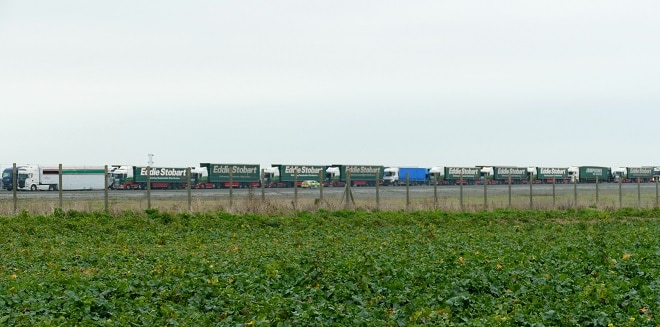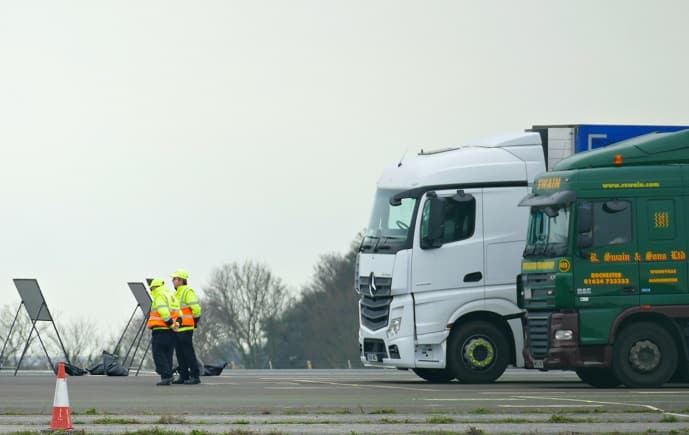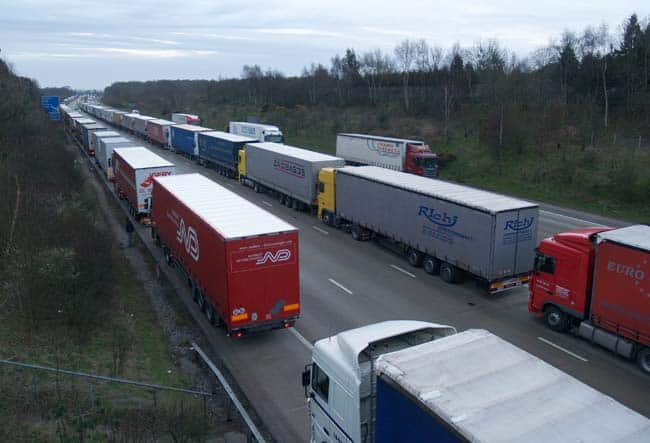
Plans on how Kent will deal with potential traffic disruption at the end of the Brexit transition period on January 1 have been published.
When the transition period ends, the UK will no longer be a member of the Single Market or the Customs Union.
New border controls and checks will be implemented which will impact the short Channel crossings.
The UK will be treated by the EU as a third country and will be subject to full third country controls and a variety of border checks.
This has the potential for delays to the crossing of the short straits and the need to manage HGV queues.

Known as Operation Fennel, the plan was developed by the multi-agency Kent Resilience Forum (KRF) in partnership with national government.
The Forum includes organisations such as Kent Police, Kent Fire and Rescue Service, South East Coast Ambulance Service, Kent County Council, Medway Council and the district and borough councils, working alongside government departments including Border and Protocol Delivery Group, Department for Transport and Highways England and HMRC.
Now available to view on the Kent Prepared website, the document outlines the arrangements to ensure the M20 can be kept open to traffic and that disruption for local residents, businesses and other road users is kept to a minimum, whilst providing temporary traffic holding areas.
Operation Fennel, which also covers driver welfare and non-freight traffic, is designed to operate at different stages, with different options being used depending on the prevailing traffic conditions.
The plans can cope with up to 7,000 HGVs, the maximum queue length of HGVs expected in Kent under the national reasonable worst-case scenario planning assumptions.

The plans also outline the Government’s web service which will be known as ‘Check an HGV is Ready to Cross the Border’. The service will be able to issue a digital Kent Access Permit to freight ready to cross the Straits before it enters Kent.
Mark Rolfe, Head of Kent Resilience Team said: “The Port of Dover and the Channel Tunnel are facilities of national importance.
“As the shortest crossing point between the UK and mainland Europe, the short straits ports – Port of Dover and Channel Tunnel – account for 69% of all goods vehicles and 89% of all powered goods vehicles that travel between the UK and the EU.
“Come January 1, the processing of freight and tourist traffic may lead to a risk of congestion and of journey times taking longer than they would today.

“Through the KRF we have brought together Department for Transport, Highways England, Kent Police, and Kent County Council in agreeing a single plan for Kent.
“Together we aim to keep Kent moving, preventing and minimising the impact of cross channel disruption on the community, freight and non-freight traffic and the environment.
“We will continue to operate a safe, local and strategic system using the transport network in Kent and provide reliable travel information.”
HGV holding sites
TAP 20
Capacity to hold 500 HGVs.
TAP 20 manages traffic flows during periods of disruption at the Port of Dover. It is designed to hold HGVs on one lane of the A20, preventing congestion to traffic in Dover centre.
TAP 20 is managed and maintained by Highways England and Port of Dover Police.
When Brock M20 is made active, TAP 20 will remain in place and will assist the control of freight into the Port of Dover.
Brock M20
Capacity to hold 2,000 HGVs.
Brock M20 is a tactical option available to manage traffic heading to the Port of Dover or Channel Tunnel.
Brock M20 is designed to keep the M20 open by operating a contraflow system between junctions 8 and 9 on the London-bound carriageway of the M20. The contraflow is for all traffic other than HGVs heading to the ports. The coast bound carriageway is utilised for port bound freight.
A concrete barrier, known as the Moveable Barrier Solution (MBS), will be deployed on the M20 to create the contraflow on the London-bound carriageway. This will keep the M20 open in both directions. This is managed by Highways England.
Brock M20 will be available for deployment by 30th December 2020.
The coast-bound carriageway can be used in two ways:
Brock M20 active free flow with port bound freight flowing freely on the coast-bound carriageway.
Brock active with control with port bound freight being held in two lanes on the coast-bound carriageway using traffic signals and being released to Eurotunnel or Port of Dover via TAP 20 as capacity becomes available.
Brock Manston
Capacity to hold 4,000 HGVs.
Brock Manston has been available since 2015 as a tactical option for managing disruption at the ports. It was included as part of the plans for a potential ‘no deal’ Brexit scenario in 2019 and will be available until end of June 2021.
Brock Manston is a tactical option, in Thanet, for holding HGVs prior to its release into TAP 256. Primarily Brock Manston is designed to hold Port of Dover freight and is a private contract between the Department for Transport and a contractor who will manage all activities on the site.
Brock Manston will also be used to manage HMRC customs clearance and as a border checking site to ensure that freight is border ready before it reaches the port.
Tests have been carried out to establish the safest optimum release rate of HGVs along the proposed route on the A256 to the Port of Dover, and how any impacts could be managed. Freight held at Manston will leave along the A256, and travel from the bottom of the A256 to the Eastern Docks roundabout at the entry of the port.
Appropriate signage will be placed on the strategic and local road networks to direct freight as required. The primary route to Brock Manston will be the M2/A2 corridor into the A299 Thanet Way.
TAP 256
Capacity to hold up to 450 HGVs.
HGVs will be released from Manston and held in TAP 256, meaning there is a constant supply of freight to meet the requirements of the Port of Dover.
TAP 256 is a holding area and will be positioned on the A256 Whitfield Bypass around ½ mile north of the junction with the A2. TAP 256 has a similar set up to the TAP 20, where freight bound for the port will be held at traffic lights in lane 1 on the southbound carriageway and then released as requested by the Port of Dover. The journey time from TAP 256 to the entrance of the Port of Dover will take between 5-8 minutes in normal traffic.
Kent County Council Highways is the lead agency for TAP 256.
Sevington inland border facility (IBF)
Capacity to hold 1,200 HGVs.
Sevington IBF is in Ashford, off of the A2070 and junction 10a on the M20.
From January 2021, the site will be used to manage HMRC customs clearance (inbound and outbound) and border checks to ensure that freight is ready before reaching the ports.
It will also be used as a temporary lorry park facility should additional capacity be required.
From July 2021 (Day 200) when full import controls are implemented, the site will also be used for additional HMRC checks and DEFRA checks.
Ebbsfleet
A car park at Ebbsfleet International will be used to manage HMRC customs clearance from January.
Ebbsfleet will also be used as a muster point in the event that freight carrying certain goods (seafood and day old chicks) is prioritised.
Waterbrook
The Waterbrook site is in Ashford, close to Sevington IBF.
Waterbrook will be ready by January 2021 to manage HMRC customs clearance. Depending on the dynamic traffic situation, a decision may be made to keep Waterbrook on stand-by as a contingency for Sevington IBF.
Operation Stack
Op Stack is implemented as a last resort. It is currently an emergency contingency option for managing high numbers of freight bound for the Channel Tunnel and Port of Dover so they can be kept in line, do not overly obstruct other major and local roads; and can be released fairly and in turn whenever space becomes available.
It is accepted that Kent Police and partners may have a scenario where Operation Stack is necessary. Operation Stack could therefore be introduced at any stage of the Op Fennel Plan as an emergency contingency measure, depending on the threat and risk presented.
Op Stack involves the parking of freight on the M20 motorway when the capacity for these vehicles to leave the country via the Port of Dover or the Channel Tunnel is compromised.
Compromised capacity can occur spontaneously, for a number of reasons: industrial dispute; anticipated weather conditions; major incident; or other events affecting the capacity of either the Port of Dover or the Channel Tunnel.
To view the plan, visit www.kentprepared.org.uk/end-of-transition-plans

